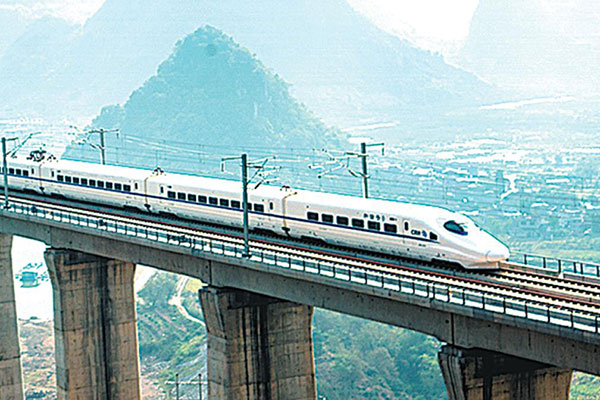
Guangxi plans to build an advanced transport network of roads, railways and airlines in the next few years[Photo by Huo Yan/China Daily]
A vital transport hub along the coast of Southwest China, the Guangxi Zhuang autonomous region aims to create a new logistics system amid opportunities brought by the China-ASEAN Expo, said a local official.
“In the next five years, we will work hard to build up transport routes by sea, land and air, and to dredge the ‘capillary vessels’ to all the expo countries,” said Peng Qinghua, secretary of the Party committee at Guangxi Zhuang autonomous region.
He explained that the region will explore new channels to connect the southern Indochina Peninsula, and the new Eurasian Continental Bridge economic corridor to follow up China’s Belt and Road Initiative.
Adjoining the expo countries by both land and sea, Guangxi now plays a key role in strengthening cooperation with ASEAN countries, Peng said.
Last year, the region invested more than 19.65 billion yuan ($3.02 billion) in railway projects, to enhance its communication with those harbors, airports, and customs offices that are open to domestic cities and ASEAN countries.
This year, airlines terminating at Nanning, the capital city of the region, have covered all the 10 countries that attend the expo. The cargo ships in Beibu Gulf port, a harbor in northern Guangxi, have been shuttling among 100 countries and regions around the world, including eight of the 10 countries attending the expo.
By land, two major expressways reaching Guangxi customs offices have been put into operation, and another one will be finished in 2017.
Nanning has been the permanent host of the China-ASEAN expo since its opening session in 2004.
It is one of the cities in the Guangxi Beibu Gulf Economic Zone, along with Beihai, Qinzhou, Fangchenggang and Yulin. The zone is a platform for international economic cooperation, created by the central government in 2008. It has become a pilot area in China to explore ties with ASEAN countries and to form a comprehensive transporting model connecting those countries.
In 2015, the zone’s GDP reached a record high of 586.73 billion yuan ($86.17 billion), more than 3 times that recorded in 2006. Even though the area equates to less than one-fifth of the land in Guangxi, the zone contributed more than one-third of the region’s total economic output and nearly one-half of its total foreign trade.
Peng said that the flourishing of transportation has also triggered the growth of foreign trade in the region.
Statistics show that before China-ASEAN relations started in their current format in 1991, the bilateral trade volume between Guangxi and ASEAN countries totaled only $7.96 billion.
The figure hit $100 billion in 2004 when the first expo was held.
Since then, the scale of the expo has continued to expand, with trade volume surpassing $472 billion last year, 59 times that of 1991.
“We are willing to give full play to the role of the ‘Nanning channel’ for the benefit of the people along the border, and to achieve shared opportunities and common prosperity,” Peng said.
